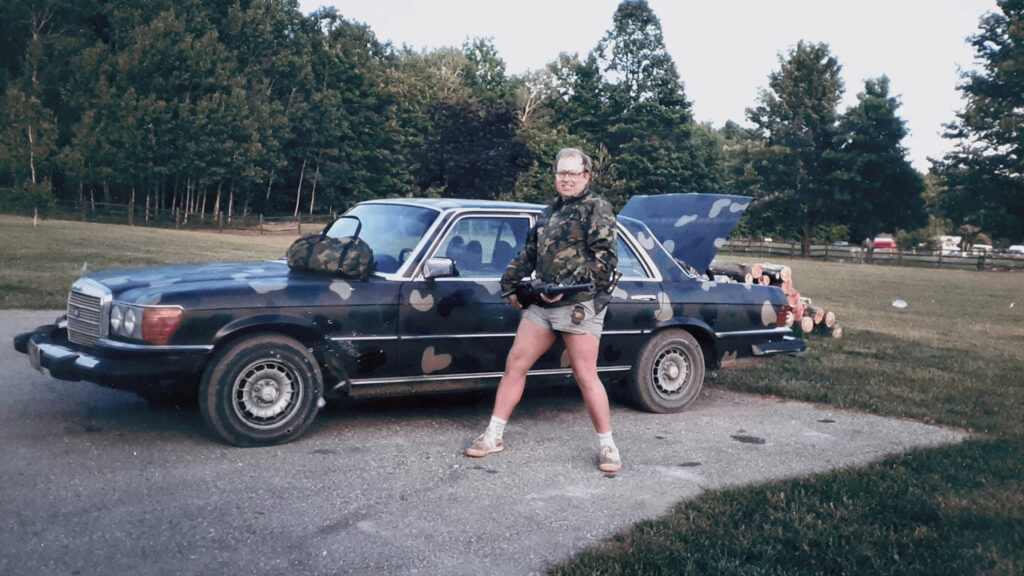2nd Chance, a documentary directed by Ramin Bahrani that premiered at the 2022 Sundance Film Festival on January 22, documents the rise and fall of Richard Davis, founder of Second Chance Body Armor, through home videos, advertisements, and testimonies from those in his sphere of influence. The film paints a vivid picture of Davis while extending time to the people important to his story, especially Aaron Westrick, who was both saved by Davis and the man to bring down his body armor operation.
The introduction to Richard Davis is an explosive one: he is shown in grainy footage aiming a gun at his own chest. The audience soon learns that this is Davis’ signature way of proving the mettle of his bulletproof vests. Bahrani takes the viewer through Davis’ origin story: after being robbed at gunpoint while working at a pizza place, Davis took it upon himself to create body armor, first sewing each vest by hand. He took his show on the road, traveling to police departments around the country and showcasing his product in the most effective way possible: shooting himself point-blank while wearing the vest and then turning around quickly to shoot at bowling pins or bottles. The quick motions after the shot to the chest signify that someone wearing a Second Chance vest would not be incapacitated; rather, they could immediately begin firing at the opponent.
The audience takes a look at Davis’ provocative ways of advertising Second Chance vests, which grew in popularity to the point where a Second Chance factory in Central Lake, MI became the town’s primary employer and Davis a “civic leader” in the community. Davis evolved from the head of Second Chance to a writer, director, and filmmaker, promoting his body armor through films that glamorized cops and violence against perpetrators and condemned criminality.
The documentary also tracks Davis’ personal relationships during the rise of Second Chance: several people from his life speak about Davis, his mentality towards the business, and their experiences with this larger-than-life figure. A duality is struck between Davis and Aaron Westrick, who was one of many “saves,” meaning his life was saved with a Second Chance vest. Westrick was shot in the line of duty and shot back at his attacker. The shots were non-lethal, but Westrick says that his superior insinuated that he should have killed his attacker on the spot. Herein lies a marked difference between Davis and Westrick’s philosophies: if a police officer who was saved by a Second Chance vest killed their shooter, they’d be rewarded with a gun. This dichotomy leads to a moving reconciliation between two figures later on in the film – though perhaps not between who you’d expect.
As the documentary runs, Bahrani begins to unravel Davis’ transgressions, like when he tried to bribe and then threaten a young man into taking the fall for a stray bullet landing in a woman’s home. Even the pizza robbery origin story is brought into question.
Both Davis’ ex-wives appear in the documentary, as well as his son Matt, who went into the family business. Bahrani illustrates how Davis’ father, a World War II veteran, cast a large shadow on Davis’ life and business. More interpersonal politics and conflicts arose when Westrick and others working at Second Chance, then a company with several government contracts supplying body armor for police and military personnel, noticed that a new fiber, Zylon, was degrading faster than intended. When one person working on the vests asked questions about Zylon, they took away her keys. Westrick also tried to flag issues with the Zylon vests and eventually became a whistleblower when the company began to knowingly sell the defective bulletproof vests, putting countless lives in danger. The documentary features the family of one slain police officer, Tony Zeppetella, who was killed while wearing a Second Chance vest. The autopsy confirmed that the bullet went straight through his vest, though in an interview Davis remains convinced that Zeppetella’s killing was not the fault of the vest.
The documentary circles back to Westrick, who eventually began to wear a wire to work at the behest of the government. Davis and Westrick reflect back on the recordings in different ways, and Westrick and his wife Kim discuss the whistleblower retaliation that their family endured. By the end of the documentary, a viewer has much to consider: good vs. evil, the nature of humankind and the inevitability of violence, and, subsequently, the need to protect oneself.
Stephen M. Kohn, Westrick’s lawyer, told WNN that he saw 2nd Chance as “a story of two people, two worldviews of human nature.” He thought that the documentary would just be a biopic of Davis but thought the film posed several philosophical questions: “Who do you want to be? What are your values? Do you react with truth, compassion, and responsibility or do you try to obstruct justice?” Kohn asks, “When you realize that your vest may kill a police officer, what do you do?”
Winners of the Sundance 2022 Film Festival will be announced on January 28 at 3pm MST.
View the webpage for 2nd Chance here.
Read a Whistleblower of the Week about Aaron Westrick here.
Read a film review of United States vs. Reality Winner here.
